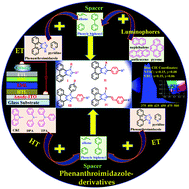Recent development of phenanthroimidazole-based fluorophores for blue organic light-emitting diodes (OLEDs): an overview
Abstract
The imminent global energy crisis and continuing inefficient energy utilization are driving the development of smart energy-efficient devices for display and lighting applications. Energy-efficient organic light-emitting diodes (OLEDs) are considered one of the most competitive candidates for next-generation smart displays and particularly for future energy-saving lighting sources. Recently, much effort has been devoted to attempts to generate white OLEDs comprising both fluorescent and phosphorescent materials. Efficient blue-emitting materials are extremely essential for the commercialization of white OLEDs and play a vital role in energy-efficient solid-state lighting and smart display devices. The molecular designing of efficient deep-blue materials is limited due to their intrinsic wide bandgap, poor carrier charge balance, and low efficiency in the solid state. In recent decades, phenanthroimidazole (PI)-based materials have attracted tremendous interest (due to the ease of their chemical/structural modification at the N1 and C2 positions) to produce efficient deep-blue OLEDs (satisfying the color purity criteria given by the National Television System Committee (NTSC)) (CIE: 0.14, 0.08) and European Broadcasting Union (EBU) (CIE: 0.15, 0.06). This review mainly focuses on the design of PI-based blue/deep-blue emitting materials and their applications in OLEDs. Here at first, some of the PI-based blue-fluorescence emitters endowed with unipolar and bipolar-transporting abilities are comprehensively reviewed. Then attention is focused on the typical PI-based host materials for phosphorescent OLEDs. Finally, PI-based hybridized local and charge-transfer (HLCT) active fluorescent emitters are presented in brief. The rational molecular design concepts and general synthetic routes for PI-based materials are briefly discussed.

- This article is part of the themed collection: Recent Review Articles


 Please wait while we load your content...
Please wait while we load your content...